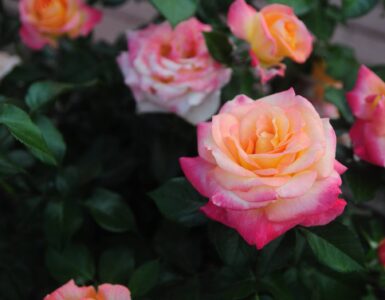Gardeners can get picky about their garden tomatoes.
It may be the geekiest thing about your garden. Some of us carefully pick and choose the tomatoes we would like to grow every year.
Horticulturist Sheriden Hansen admits it can be a bit of a hobby, even an obsession, but we just want to know some basics – what will work for what we need.
Find more gardening at extension.usu.edu/botanicalcenter.
Getting Geeky About Garden Tomatoes
Every year I plant about 20 new varieties that I have never tasted and a few standards that I know I love. There is so much diversity in tomatoes it can be hard to decide what to plant, so determining your reason for planting can definitely help to narrow down the selection.
Are you wanting to preserve the harvest? Eat fresh? Save genetic diversity? Preserve a story? Do you want a variety of color and flavor? Or are you after a handful of tomatoes that you can snack on while you work in the garden? Are you adventurous in the kitchen or do you like a standard tomato? This can really help to determine what you plant.
Space also can play into selection. There are varieties that are made for patios (Burpee has a whole page dedicated to container vegetables including tomatoes) and new microtomatoes. If you have a large space to fill, you may want to consider larger tomatoes such as the indeterminate types.
Sheriden’s Standard Favorites that she plants every year:
Better Boy
Green Zebra
Goldman’s Italian American
Costoluto Genovese
There are two ways to think about tomatoes: GROWTH HABIT (determinate vs. indeterminate) and GENETICS (hybrid vs. heirloom).
Growth habit (determinate vs. indeterminate)
- Determinate –These have a bushy rather than vining growth habit and flower and produce a single crop that ripens mostly at the same time. Usually indeterminate tomatoes are used for making sauces or for sun drying (Principe Borgese). There are a few slicing tomatoes that fall into this category like Celebrity.
- Pros: smaller plants that are better for containers or smaller gardens
- Cons: single harvest, many tend to be prone to blossom end rot
- Best determinate tomatoes:
- San Marzano – classic paste tomato
- Amish Paste – classic paste tomato
- Principe Borgese – traditional tomato for making sundried tomatoes
- Celebrity – slicing tomato, reliable yields, classic red tomato flavor
- Indeterminate – these tomatoes are vining – they will grow as long as conditions support growth, which means warm temperatures above 50 F, plenty of water (about 2-inches per week), and access to nutrients and sunlight. Indeterminate types can easily be trellised and pruned to a single or double vine to save space in the garden. Generally, these are slicing types.
- Pros: tomatoes producing throughout the season, can be trellised and trained
- Cons: take up more space
- Best indeterminate tomatoes:
- Better Boy – excellent slicing tomato that produces high yields of medium-sized, red tomatoes
- Early Girl – earlier producer, high-yielding, red slicer that is very popular and easy to find in nurseries
- Brandywine – classic giant slicing tomatoes that can be slightly fluted or ruffled. They can be pink, red, and purple and are definitely a showstopper!
- Cherry tomatoes like Sungold (orange) and Super Sweet 100 (red)
Genetics (hybrid vs. heirloom)
- Hybrid – these tomatoes are bred and crossed to support certain characteristics such as yield, size, and disease resistance. You cannot save seeds from these tomatoes for your garden next year because they are not genetically stable.
- Pros: you get uniform, typically high-yields of tomatoes with healthy, vigorous plants
- Cons: you can’t save seed and seed tends to be expensive
- Best hybrid tomatoes:
- SuperSauce – massive red sauce tomatoes, excellent for processing
- Steakhouse – XL slicing tomatoes that hold the record for the largest tomatoes ever grown
- Big Boy – arguably one of the greatest tomatoes of all time – prolific yields, uniform and great tasting red tomatoes
- Microtomatoes – these are new hybridizations that produce micro-sized tomatoes with heavy harvests for the size. They are still fairly new to the market but are FUN and great for limited space gardens
- Heirloom – heirloom tomatoes are genetically stable and open pollinated (no one is crossing the tomatoes). They have been around for 50+ years and most of them have a story to tell and can romanticize the garden with their histories. Seeds from these can be saved.
- Pros: you support genetic diversity by planting and are rewarded with some of the most incredible flavors you will ever taste. You can save seeds for your garden next year.
- Cons: can be less yielding than the hybrids, usually thinner skinned and don’t store well (eat promptly).
- Mortgage Lifter – beautiful red tomato with a story about selling the tomato starts for $1 each, Mr. Byle’s $6,000 mortgage was paid off
- Goldman’s Italian American – fluted tomato that was found at a roadside stand in Italy and named for Amy Goldman’s Father and his Brooklyn Grocery Store where the tomatoes were sold. Excellent fresh or used as a sauce tomato.
- Pineapple – a gorgeous yellow and orange tomato that produces fruit up to 2 pounds
- German Pink – this is the tomato that ignited the heirloom movement in America. A giant pink slicing tomato from Bavaria brought to the US in 1883. One of my all-time favorites!
- Green Zebra – a small salad tomato with incredible flavor. Ripe tomatoes turn yellow to lime green with dark green striping.
- Cherokee Purple – one of the most popular heirlooms that boasts a traditional or classic flavor with a lot of depth. Thought to have been passed down from Native Americans from the Cherokee tribe in Tennessee. A great slicer and good producer.
Sheriden Hansen serves as an assistant professor of horticulture with the Utah State University Extension. She holds a Masters in Plant Science from Utah State University. Sheriden loves to teach about fruit and vegetable production, how to grow crops in small spaces and container gardening. Sheriden is married with two sons. She is a registered nurse and beekeeper.
Sheriden is with the USU Botanical Center in Kaysville. Here you will find beautiful walk-through gardens and a full roster of classes and family activities. Get connected with the Botanical Center here: extension.usu.edu/botanicalcenter/















Add comment